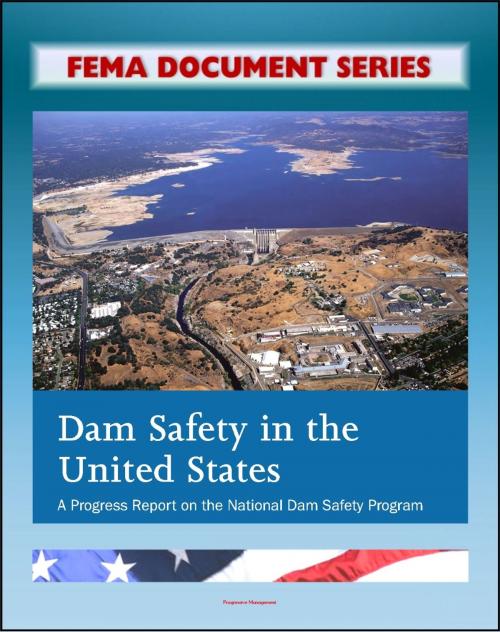FEMA Document Series: Dam Safety in the United States - A Progress Report on the National Dam Safety Program - FEMA P–759
Nonfiction, Science & Nature, Science, Biological Sciences, Ecology, Social & Cultural Studies, Political Science, Government| Author: | Progressive Management | ISBN: | 9781458184399 |
| Publisher: | Progressive Management | Publication: | June 21, 2011 |
| Imprint: | Smashwords Edition | Language: | English |
| Author: | Progressive Management |
| ISBN: | 9781458184399 |
| Publisher: | Progressive Management |
| Publication: | June 21, 2011 |
| Imprint: | Smashwords Edition |
| Language: | English |
This Federal Emergency Management Agency (FEMA) document is a report submitted to Congress outlining progress in the National Dam Safety Program. Dams are a vital part of our Nation’s infrastructure, providing economic, environmental, and social benefits, including hydroelectric power, river navigation, water supply, wildlife habitat, waste management, flood control, and recreation. The benefits of dams, however, are countered by the risks they can present. In the event of a dam failure, the potential energy of the water stored behind even a small dam is capable of causing loss of life, significant property damage, and an extended period of denial of the services dams provide. For almost 30 years, reducing the risk of dam failure has been the cornerstone and driving force of the National Dam Safety Program. The purpose of the National Dam Safety Program is to “reduce the risks to life and property from dam failure in the United States through the establishment and maintenance of an effective national dam safety program to bring together the expertise and resources of the federal and non-federal communities in achieving national dam safety hazard reduction.” Central to the safety mission of the Program is ensuring that the public and property owners downstream of potentially deficient dams be informed of the risk from dam failure. The objectives of the National Dam Safety Program are to: ensure that new and existing dams are safe through the development of technologically and economically feasible programs and procedures for national dam safety hazard reduction; encourage acceptable engineering policies and procedures to be used for dam site investigation, design, construction, operation and maintenance, and emergency preparedness; encourage the establishment and implementation of effective dam safety programs in each state based on state standards; develop and encourage public awareness projects to increase public acceptance and support of state dam safety programs; develop technical assistance materials for federal and state dam safety programs; develop mechanisms with which to provide federal technical assistance for dam safety to the non-federal sector; and develop technical assistance materials, seminars, and guidelines to improve security for dams in the United States.
This report to Congress describes the achievements of the states, the federal agencies, and their partners in meeting these objectives and reducing losses from dam failure nationwide. The final chapter of this report includes recommendations for strengthening the National Dam Safety Program and objectives for the Program to realize the larger goal of keeping the American public safe from dam failure.
As a bonus, this compilation includes the up-to-date U.S. Army Training and Doctrine Command (TRADOC) handbook on terrorism, the Military Guide to Terrorism in the 21st Century. A Military Guide to Terrorism in the Twenty-First Century is a reference guide prepared under the direction of the U.S. Army Training and Doctrine Command (TRADOC), TRADOC G2 as a capstone reference guide on terrorism. Understanding terrorism spans foreign and domestic threats of nation-states, rogue states with international or transnational agents, and other actors with specific strategies, tactics, and targets. This terrorism guide addresses foreign and domestic threats against the United States of America in a contemporary operational environment (COE). This informational handbook supports institutional training, professional military education, and operational missions for U.S. military forces in the War on Terrorism (WOT).
This Federal Emergency Management Agency (FEMA) document is a report submitted to Congress outlining progress in the National Dam Safety Program. Dams are a vital part of our Nation’s infrastructure, providing economic, environmental, and social benefits, including hydroelectric power, river navigation, water supply, wildlife habitat, waste management, flood control, and recreation. The benefits of dams, however, are countered by the risks they can present. In the event of a dam failure, the potential energy of the water stored behind even a small dam is capable of causing loss of life, significant property damage, and an extended period of denial of the services dams provide. For almost 30 years, reducing the risk of dam failure has been the cornerstone and driving force of the National Dam Safety Program. The purpose of the National Dam Safety Program is to “reduce the risks to life and property from dam failure in the United States through the establishment and maintenance of an effective national dam safety program to bring together the expertise and resources of the federal and non-federal communities in achieving national dam safety hazard reduction.” Central to the safety mission of the Program is ensuring that the public and property owners downstream of potentially deficient dams be informed of the risk from dam failure. The objectives of the National Dam Safety Program are to: ensure that new and existing dams are safe through the development of technologically and economically feasible programs and procedures for national dam safety hazard reduction; encourage acceptable engineering policies and procedures to be used for dam site investigation, design, construction, operation and maintenance, and emergency preparedness; encourage the establishment and implementation of effective dam safety programs in each state based on state standards; develop and encourage public awareness projects to increase public acceptance and support of state dam safety programs; develop technical assistance materials for federal and state dam safety programs; develop mechanisms with which to provide federal technical assistance for dam safety to the non-federal sector; and develop technical assistance materials, seminars, and guidelines to improve security for dams in the United States.
This report to Congress describes the achievements of the states, the federal agencies, and their partners in meeting these objectives and reducing losses from dam failure nationwide. The final chapter of this report includes recommendations for strengthening the National Dam Safety Program and objectives for the Program to realize the larger goal of keeping the American public safe from dam failure.
As a bonus, this compilation includes the up-to-date U.S. Army Training and Doctrine Command (TRADOC) handbook on terrorism, the Military Guide to Terrorism in the 21st Century. A Military Guide to Terrorism in the Twenty-First Century is a reference guide prepared under the direction of the U.S. Army Training and Doctrine Command (TRADOC), TRADOC G2 as a capstone reference guide on terrorism. Understanding terrorism spans foreign and domestic threats of nation-states, rogue states with international or transnational agents, and other actors with specific strategies, tactics, and targets. This terrorism guide addresses foreign and domestic threats against the United States of America in a contemporary operational environment (COE). This informational handbook supports institutional training, professional military education, and operational missions for U.S. military forces in the War on Terrorism (WOT).















